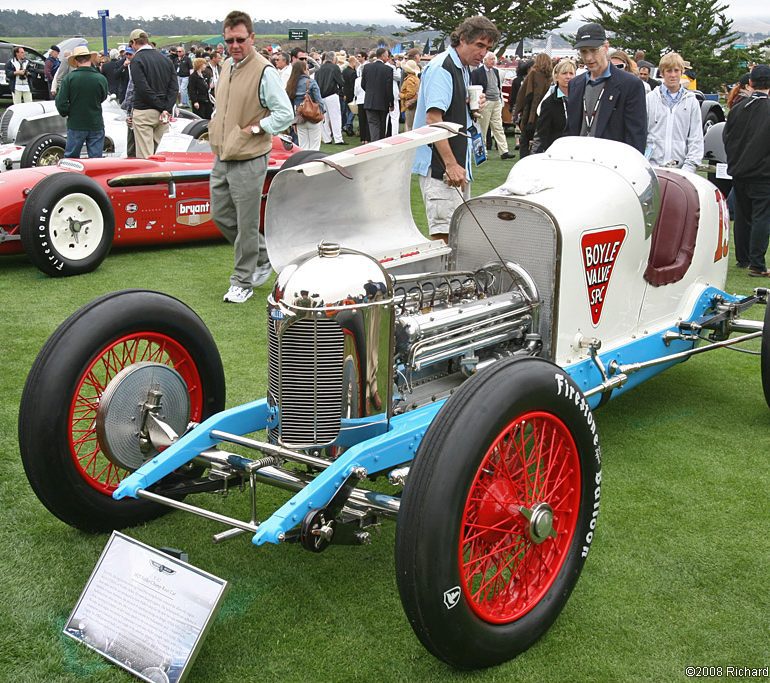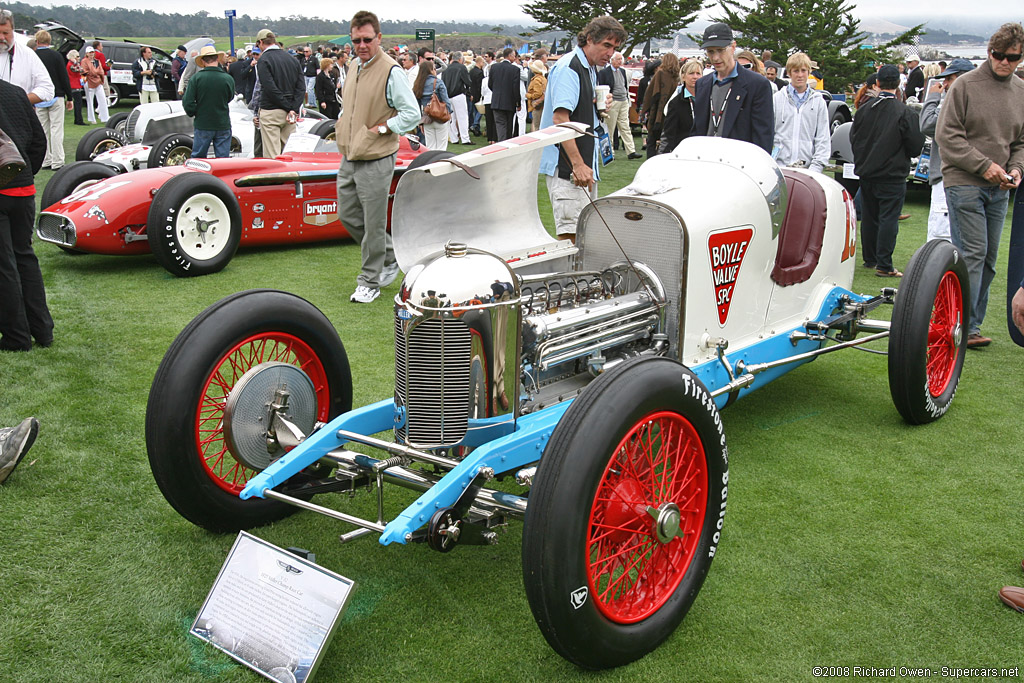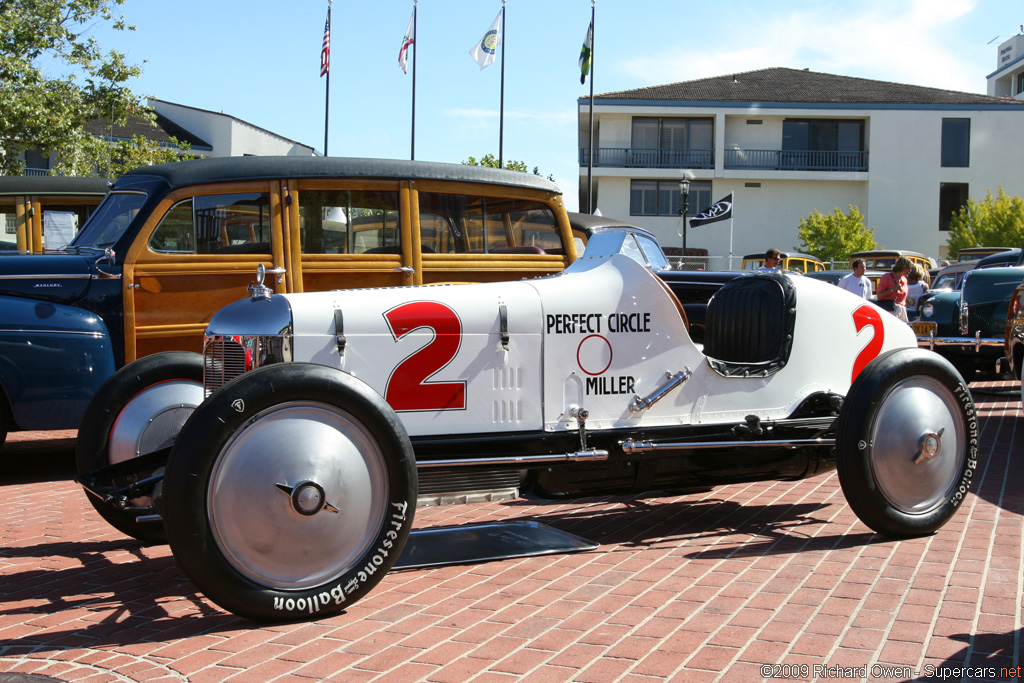1926 Miller 91
From 1926 to 1929, the Miller 91 was a dominant car in American racing. This model usually filled more than half the grid at the Indianapolis 500 and won the event outright in 1926, 1928 and 1929. It was the only series production model to race Indianapolis and was surrounded by various American specials to complete for these victories.
With the 1926 regulations that limited engine size to just 91 in³ (1.5 liters), Miller had to create a new engine for his new cars and his existing customers. These were built to same winning standards as Harry A. Miller’s Indianapolis winners. Almost the entire car was forged and fabricated on site and each was a engineering marvel.
Miller produced both a rear-wheel drive (RWD) and front-wheel drive (FWD) version of the 91. At $15,000 USD, the 91 FWD was one of the most expensive cars available. This didn’t stop at least 10 FWD cars from being made. These were joined by at least nine RWD cars. Many of them had detail differences and fancy names but the overall design was the same.
To make up the lack of displacement, Miller and his team fitted a centrifugal supercharger. Some of the very first blown Millers appeared in 1925, on the 122. By the time the 91 in³ formula was set, Miller could already produce more power from the smaller displacement. With nearly 250 bhp on tap, the 91 could top out 171 mph. Like the 122, Miller used a DOHC setup which Bugatti would later use on the Type 51.
Millers dominated the 91 in³ (1.5 liters) formula and filled most of the Indianapolis field from 1926 to 1929. Unfortunately, the 91 was the last successful car sold by Miller. His company failed with crash of 1929 and he was bankrupt three years later.
In Detail
| tags | indianapolis |
| submitted by | Richard Owen |
| type | Racing Car |
| built at | Los Angeles, California |
| engineers | Harry A. Miller |
| price $ | $ 10,000 |
| engine | Inline-8 |
| block material | Cast Iron w/Aluminum Crankcase |
| displacement | 1478 cc / 90.19 in³ |
| bore | 55.5 mm / 2.2 in |
| stroke | 76.2 mm / 3.0 in |
| power | 186.4 kw / 250 bhp @ 8000 rpm |
| specific output | 169.15 bhp per litre |
| body / frame | Aluminum over Steel Chassis |
| driven wheels | RWD |
| front brakes | Drums |
| rear brakes | Drums |
| f suspension | De Dion Tube Axle w/Twin Reverse Quater-Elliptic Leaf Springs |
| r suspension | De Dion Tube Axle |
| transmission | 3-peed Manual |
| top speed | ~275.14 kph / 171 mph |
Auction Sales History
1927 Miller 91 Rear Drive Racing Car – did not sell for $380,000
Owning a 91 rear drive was very high on Chuck’s list of Miller priorities. His dragnet for parts was turning up bits and pieces of 91s in numerous places. Everything that could be bought was either going be incorporated in his project or used as trading stock. If the part could not be bought he would borrow it and have it duplicated. There was one discovery that cast the die for what car would be built. Chuck found an original intercooler that had been made by one of the greatest heroes in the Miller racing story, Frank Lockhart. With Lockhart’s intercooler in hand Chuck could give his 91 an identity, the 1927 Perfect Circle Miller, the car in which the intercooler had in fact been used.
The story of Lockhart’s 1926 rookie victory at Indianapolis is one of the Speedway’s most enduring legends. Besides being a driver with natural skill and daring that many believe has never been seen since, Lockhart had an innate gift for engineering.
Over the winter months of 1926-27, in shop space on the top floor of the Howard Buick Agency in Los Angles, Lockhart and the Wiesel brothers, John and Zenas, designed, built and developed a special manifold to cool the fuel charge between the supercharger and the carburetor. The resulting increase in horsepower was amazing. Termed an intercooler, Frank was granted a patent for its design.
At Muroc Dry Lake in April with the still-secret intercooler in place, Frank was clocked by the AAA at a two-way average speed of 164.02 mph – a world record for 1.5-litre cars. His one-way time of 171.02 mph fueled his passion to capture the land speed record, a passion that led to his death.
In 1927, Lockhart, driving his 1926 winning car, now intercooler equipped and sponsored by the Perfect Circle Piston Ring Company, took pole position at Indianapolis with a speed of 120.100 mph. He completely dominated the race until a connecting rod failed on the 120th lap. In addition, he drove the car to nine major wins in the remainder of the 1927 season. Lockhart died on April 25, 1928 in his Stutz Blackhawk trying to set a new land speed record.
After Lockhart’s death the Perfect Circle Miller was renamed the Stutz Blackhawk Special and passed to driver Tony Gulotta who finished 10th in the 1928 Indianapolis 500. It was next purchased by Alden Sampson who put Louis Meyer in the seat. Meyer won both the 1928 and 1929 AAA Championships in the car and finished 2nd at Indianapolis in ’29. In 1930 the engine, sans intercooler, was paired with another 91 in the twin engine Sampson Special.
The ex-Lockhart chassis was repowered with a 230 cubic inch Miller Big 8 and driven at Pacific Coast dirt track events by Meyer. In 1931 the chassis was parted out with the axles probably going into a Jadson Special Dirt Car and the frame, steering and cowl used as the basis for Bill White’s Ascot Sprint car. White’s driver, Ernie Triplett, won the 1931 and 1932 pacific Coast Championship in this car.
By 1935 the White/Triplett car had passed to Russ Garnett who modified the frame and suspension to a three-spring set up. Driver Harris Isinger was killed in the car at Oakland. The engine was saved but the wrecked chassis with lineage to the 1926 Indianapolis winner and 1927 Perfect Circle Miller passed into oblivion – a sad fate that befell every 91 cubic inch rear drive.
With such a compelling history, Chuck dedicated his full attention to making the car as authentic as possible. He found a useable engine, purchased two N.O.S. ex-Duray cylinder blocks from a Bugatti collector in England and turned up a complete original transmission in Indianapolis.
Bob Sutherland, a Colorado sports racing car and Miller enthusiast was also building a 91 Rear Drive from parts, the 1929 Majestic Special. He and Chuck developed a mutually beneficial arrangement so that efforts on making parts were not duplicated. Sutherland, through his Maserati connections had met several English restoration specialists who were enthusiastic about Millers and both Miller projects traveled across the Atlantic to take advantage of their craftsmanship. Peter Shaw built the frames and chassis bits while Paul Weldon at Church Green Engineering formed the bodies.
Chuck’s efforts culminated in a complete and viable car ready for cosmetics. Olendorf Restorations was selected to handle the paint. While the car was being painted Chuck met Dave Hentschel, a highly skilled restorer. After the painting Dave took over the project, rebuilt the driveline and conducted the final assembly, bringing the car to completion. The spectacular result made its debut to the enthusiast crowd at the first ever Miller gathering held at Monterey in 1993.
It is not an exaggeration to say that this car could not be duplicated today. With no known original Miller 91 rear drive cars surviving, this is quite simply a once in a lifetime opportunity to own the best of recreations, carefully assembled by an incredibly dedicated Miller enthusiast and containing many original parts. The fact that the intercooler connects it to the Lockhart saga and Louis Meyer makes it singular and irreplaceable.
Auction Source: 2009 RM Auctions Sports & Classics of Monterey






